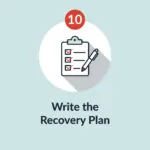
Minimizing Downtime With a Comprehensive Disaster Recovery Plan Checklist
Preparing for recovery starts long before a disaster occurs. Use this checklist to help plan ahead to minimize disruptions and downtime from any business disaster.

When a disaster strikes—whether it’s a crippling ransomware event or a destructive natural disaster—a smooth recovery process is critical to getting back on your feet. But that recovery doesn’t simply unfold as soon as the storm recedes. Rapid operational recovery starts with planning long before the disaster even occurs.
Before Hurricane Michael hit Panama City in 2018, Coca-Cola Bottling Company UNITED, Inc., thought they were thoroughly prepared for the storm and recovery. “We have a really extensive hurricane preparedness plan across all of our coastal locations,” explains Gianetta Jones, Vice President & Chief People Officer. But the Category 5 storm caused severe damage to cell phone infrastructure that the Coca-Cola team was not ready for. Gianetta told us on The Employee Safety Podcast, “We had to pivot and purchased several very expensive satellite phones for our operators that were local to be able to communicate with us at the corporate office.”
Flexibility is necessary in disaster recovery, as disasters hardly follow a predictable plan. But the right preparation can make it possible to adapt and maximize your time and resources through recovery. A comprehensive disaster recovery plan is not just a “good-to-have” safety net; it serves as a roadmap for resuming operations efficiently and effectively, minimizing the impact on your business and clients. And a great way to get started on your disaster recovery planning process (or to review and reassess your standing plan) is with a disaster recovery plan checklist.
Whether you’re facing natural calamities, cyberattacks, or technological failures, this checklist will guide you through establishing robust protocols to protect your assets, data, and your operational continuity.
Disaster Recovery Plan Template

13-Step Disaster Recovery Plan Checklist
 1. Assess the risks and impacts
1. Assess the risks and impacts
Conduct a thorough risk assessment to identify potential disasters and emergencies and look for vulnerabilities. Then, perform a detailed business impact analysis to understand the potential impact of disasters on your business operations. These assessments will help you determine what disasters you must prepare for and what recovery might be necessary.
 2. Coordinate with departments and identify stakeholders
2. Coordinate with departments and identify stakeholders
Engage all internal departments to gather input and ensure comprehensive coverage. In particular, you’ll want to work with teams involved in emergency preparedness, IT, business continuity, security, and any other function that may be impacted by the event. Additionally, determine any stakeholders, internal and external, crucial to the recovery processes.
 3. Review past emergencies
3. Review past emergencies
Analyze any previous incidents your organization has been through to learn from past emergencies and refine your current planning efforts. You can also look at organizations similar in size and industry to understand how they have experienced disasters.
 4. Assemble the leadership team
4. Assemble the leadership team
The disaster recovery team members will be dedicated to managing the disaster recovery process, though not necessarily executing the entire disaster recovery plan themselves. They will serve as important leaders and decision-makers throughout the process.
 5. Document systems and processes
5. Document systems and processes
Thoroughly record all critical business systems and processes. This might include software applications, physical items in your facility, digital systems, on-site and off-site resources, or processes vital to your operations. If it is something that a disaster might impact, it should be considered in this step.
Once you have your list, do the following for each item:
|
For example, when building an IT disaster recovery plan, you’ll want to document all your IT systems, identify the most critical pieces of IT infrastructure, and arrange for data backups, secondary data centers, and other data protection for any critical data that may be impacted.
 6. Analyze your recovery needs
6. Analyze your recovery needs
Perform a detailed recovery analysis for each type of disaster that could impact the business. Include the following steps in this analysis:
|
 7. Set up your recovery plan templates
7. Set up your recovery plan templates
If you are using a disaster recovery plan template, you’ll want to make copies of the template pages to fill out. You want a tailored recovery plan for each type of disaster, so multiple versions of the template are a must.
 8. Assign personnel
8. Assign personnel
Identify and document all personnel who will be involved in each recovery and response plan. Write down their roles and responsibilities within the recovery efforts and contact information.
 9. Establish the activation criteria
9. Establish the activation criteria
Set clear criteria for when to activate the disaster recovery plan. Clarify the turning point between disaster response procedures and disaster recovery, so you don’t hesitate in the event of a disaster.
 10. Write the recovery plan
10. Write the recovery plan
The previous disaster recovery checklist stages prepare you to document your plan. Detail the specific steps and strategies to recover from each disaster you may face.
 11. List resources and related documents
11. List resources and related documents
Document all the resources required for the recovery plan and their locations. Include links or references to any related plans and supportive documentation. This might include your business continuity plan, risk assessments from earlier in the process, or documentation for a specific recovery strategy.
 12. Develop a communication plan
12. Develop a communication plan
Communication is critical to recovery, so ensure your plan includes a clear process for reaching your employees, stakeholders, and external resources. Design a comprehensive emergency communication plan detailing:
|
 13. Evaluate your response
13. Evaluate your response
Don’t make the mistake of building out your disaster recovery plan and assuming it can stay the same year after year. Not only are the disaster scenarios you face likely to change, but your organization will also grow and change; what worked for recovery at one point won’t necessarily work weeks, months, or years later. Regularly test, evaluate, and update the disaster recovery plan to ensure it still meets your business needs over time.
Planning for Resilience Through Operational Failback
With the right plan in place, recovery doesn’t have to feel like a disaster in and of itself. Develop a comprehensive disaster recovery plan with this checklist to keep your whole team on the same page and align their efforts.
Unlike an IT system failback, to recover your business operations, you often need to build them back up one by one. Following all 13 steps, you can ensure you don’t miss a critical system in your DR plan, and you minimize the effort it takes to quickly and confidently return to normal operations.




